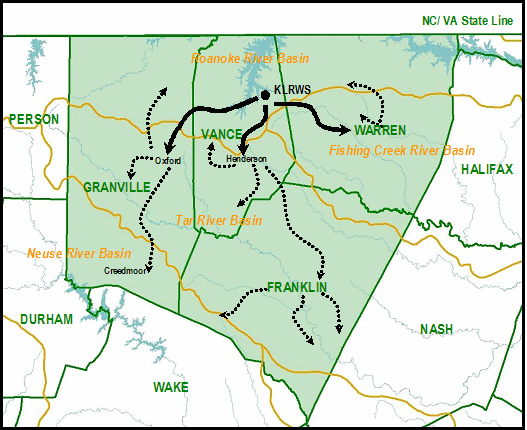KERR LAKE REGIONAL WATER SYSTEM INTERBASIN TRANSFER CERTIFICATION REQUEST
KERR LAKE REGIONAL WATER SYSTEMINTERBASIN TRANSFER CERTIFICATION REQUEST
| Primary Applicant: | Kerr Lake Regional Water System (CH2MHill consulting) | Source Basin: | Roanoke |
| Receiving Basins: | Tar, Fishing Creek, Neuse | |
| Maximum Daily IBT request based on 2040 demand: | ||
| Roanoke to Tar: | 22.48 MGD | |
| Roanoke to Fishing: | 1.63 MGD | |
| Roanoke to Neuse: | 2.4 MGD | |
The Kerr Lake Regional Water System (KLRWS) is a regional provider of drinking water. The system sells bulk water to Henderson, Oxford, and Warren County. These three customers, in turn, serve portions of Vance, Granville, Franklin, and Warren Counties.
KLRWS has an existing, grandfathered, surface water transfer capacity of 10 MGD. The grandfathered capacity allows the system to move water from the Roanoke River Basin (Kerr Lake) to the Tar and Fishing Creek River Basins, both of which are sub-basins to the Tar-Pamlico Major River Basin. On February 18, 2009, KLRWS submitted a Notice of Intent to Request an Interbasin Transfer (IBT) Certificate to the Environmental Management Commission. In that notice KLRWS requested to increase the authorized transfer from 10 MGD to 24 MGD, and to transfer 2.4 MGD from the Roanoke River Basin to the Neuse River Basin. These transfer amounts are based on water use projections to the year 2040.

KLRWS has submitted the first IBT request that is required to comply with NC General Statute §143-215.22L. This statute supersedes previous statutes and requires more thorough evaluation and broader notification than was required in the past.
Current Status:
The Division of Water Resources is currently updating the Roanoke River Basin Hydrologic Model. Once the model is updated, the applicant will use it to evaluate impacts of the proposed transfer on the Roanoke River Basin. Those impacts will be discussed in an Environmental Impact Statement (EIS) that must address the following requirements, which are also set forth in G.S. §113A-4 and §143-215.22L(d):
- A comprehensive analysis of the environmental impacts that would occur in the source and receiving river basins if the petition for a certificate is granted;
- Any significant adverse environmental effects which cannot be avoided;
- A description of measures to mitigate any adverse impacts that may arise from the proposed interbasin transfer;
- An evaluation of alternatives to the proposed interbasin transfer, including water supply options that do not require an interbasin transfer and use of water conservation measures;
- The relationship between the short-term uses of the environment involved in the proposed action and the maintenance and enhancement of long-term productivity and;
- Any irreversible and irretrievable environmental changes which would be involved in the proposed action should it be implemented.
Background Documentation:
- Public Meeting materials:
- Notice of Intent to Request an Interbasin Transfer Certificate (pdf) and exhibits (pdf)
- Notice of Public Meetings (pdf)
- 2008 Interbasin Transfer Certificate and Environmental Impact Statement Scoping Document (pdf)
- 2004 Draft Environmental Assessment Scope(pdf)
Path Forward:
The applicant must develop an EIS in support of its transfer request. The EIS must address the comments received during the public scoping meetings. The EMC will then schedule several public hearings and provide an additional opportunity for comment. Once the EMC has responded to relevant comments, they may determine that the EIS is complete and either accept or deny the applicant's Petition. There will be additional public hearings and opportunities to comment on the EMC's draft determination before the decision is finalized on whether or not to grant the certificate.